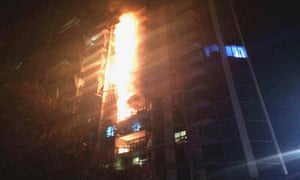The former head of Victoria’s Metropolitan Fire Brigade has said he would not allow his children to live in a Melbourne apartment block that caught fire in a similar manner to London’s Grenfell Tower, and it remained a fire risk.
Peter Rau was chief fire officer of the MFB in November 2014 when a cigarette burning on an eighth floor balcony of the Lacrosse building in Docklands sparked a fire that raced up the aluminium-clad walls to the 21st floor within 11 minutes.
A post-incident report said aluminium composite panels that were not approved for external use on a high-rise building in Australia, were the direct cause of the “speed and intensity of the fire spreadâ€.
The Grenfell Tower in west London, which caught alight on Wednesday, leaving at least 30 people dead and 70 still missing, was recently clad in aluminium panels.
The Guardian has revealed that the cladding used in Grenfell were known as “PE†panels, the type used on the Lacrosse tower. “PE†panels have a polyethylene core and are slightly cheaper than fire-resistant or “FR†panels, which include fire-retardant minerals in the polyethylene core.
The cost difference for the panels used in Grenfell was £2 per square metre; in Australia, fire-resistant panels cost about $52 per square metre, compared to $45 per square metre for a PE core.
Despite concerns raised several times by the MFP, and an order from the City of Melbourne that the panels be removed, the cladding on the Lacrosse building remains in place and a battle over who has responsibility for paying the replacement costs is now before the Victorian Civil and Administrative Tribunal.
More than 200 apartments in the building remain occupied.
Rau told Fairfax Media that not enough had changed since the 2014 fire to give him confidence the building would not burn the same way again.
Firefighters were able to evacuate the building and save its 400 residents. High-pressure water in the sprinkler system, which did not fail despite being overwhelmed by multiple points of fire, extinguished the flames inside.

About 20 apartments were deemed uninhabitable and the fire caused $5m damage, but the rest of the building was saved.
Rau said the firefighters were “really luckyâ€. He called for signs to be placed in the entrance foyer to warn residents and guests that they would need to evacuate quickly in case of a fire.
“People have the right to know,†he told Fairfax Media. “I wouldn’t allow my kids to live in the building. It’s just too a big a risk in its current state.â€
Australian building authorities are being pushed to conduct audits into the use of flammable aluminium composite panels following the Grenfell disaster, and one fire expert has compared the exercise of removing a product that has been widely used on high-rise buildings for 20 years to the task of removing asbestos.
South Australia has announced it will conduct an audit of high-rise building in Adelaide to determine which ones used the non-compliant cladding.
A similar audit in Victoria in 2015, following the Lacrosse fire, found more than half the 170 buildings assessed used aluminium composite panels in a way that did not comply with Australian building codes, but said that all were nevertheless deemed safe. In the 18 months since, more than half the buildings found in breach of the building code have been made compliant.






 Add Category
Add Category
